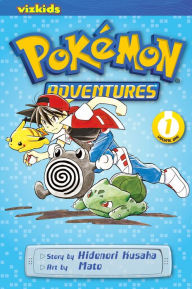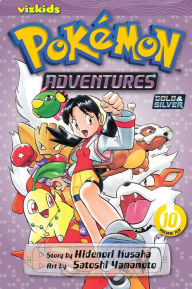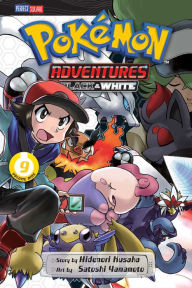The Pokémon Adventures Team Reveals How the Manga Is Made
Pokémon Adventures Gold & Silver Box Set (Set Includes Vols. 8-14)
Pokémon Adventures Gold & Silver Box Set (Set Includes Vols. 8-14)
By
Hidenori Kusaka
Illustrator
Satoshi Yamamoto
,
MATO
In Stock Online
Paperback $74.99
How do you succeed in the manga biz? The writer and artist of the Pokémon Adventures manga—two guys who ought to know—have totally different answers:
“Grit your teeth and don’t give up,” offers one.
“You should just give up,” responds the other.
Writer Hidenori Kusaka and artist Satoshi Yamamoto were special guests at Comic-Con International last month, where their appearances included a lively panel at the Grand Horton Theater in downtown San Diego. Kusaka was dressed for the occasion in a Pikachu tie and Chespin hat, while Yamamoto was a bit more understated in a bright red shirt.
Over the course of an hour, the two, along with their American and Japanese editors, answered questions, gave a short course in how manga are made, and played “Rock, paper, scissors” with the audience—for prizes!
[caption id="attachment_12432" align="aligncenter" width="642"] Hidenori Kusaka, we choose your hat.[/caption]
While the crazy popular Pokémon Go mobile game was the talk of the convention—cosplayers dressed as PokéStops!—Kusaka and Yamamoto are old Pokémon hands. The franchise celebrates its 20th anniversary this year, and Kusaka has been writing Pokémon Adventure from the first volume, which debuted in 1997. (Yamamoto joined the series with volume ten.)
The only serious moment of the panel came at the very beginning, when Gary Sassmann, director of print and digital media for Comic-Con, presented the two creators with the Inkpot Award for achievement in comic arts.
After that, the mood swung between goofy and goofier. Viz editor Urian Brown, dressed for the occasion in a Jigglypuff hat and Gengar t-shirt, was the master of ceremonies, and started by asking the creators what advice the they would give to aspiring manga-ka. That’s when the conflicting advice came up.
How do you succeed in the manga biz? The writer and artist of the Pokémon Adventures manga—two guys who ought to know—have totally different answers:
“Grit your teeth and don’t give up,” offers one.
“You should just give up,” responds the other.
Writer Hidenori Kusaka and artist Satoshi Yamamoto were special guests at Comic-Con International last month, where their appearances included a lively panel at the Grand Horton Theater in downtown San Diego. Kusaka was dressed for the occasion in a Pikachu tie and Chespin hat, while Yamamoto was a bit more understated in a bright red shirt.
Over the course of an hour, the two, along with their American and Japanese editors, answered questions, gave a short course in how manga are made, and played “Rock, paper, scissors” with the audience—for prizes!
[caption id="attachment_12432" align="aligncenter" width="642"] Hidenori Kusaka, we choose your hat.[/caption]
While the crazy popular Pokémon Go mobile game was the talk of the convention—cosplayers dressed as PokéStops!—Kusaka and Yamamoto are old Pokémon hands. The franchise celebrates its 20th anniversary this year, and Kusaka has been writing Pokémon Adventure from the first volume, which debuted in 1997. (Yamamoto joined the series with volume ten.)
The only serious moment of the panel came at the very beginning, when Gary Sassmann, director of print and digital media for Comic-Con, presented the two creators with the Inkpot Award for achievement in comic arts.
After that, the mood swung between goofy and goofier. Viz editor Urian Brown, dressed for the occasion in a Jigglypuff hat and Gengar t-shirt, was the master of ceremonies, and started by asking the creators what advice the they would give to aspiring manga-ka. That’s when the conflicting advice came up.
Pokémon Adventures (Red and Blue), Vol. 1
Pokémon Adventures (Red and Blue), Vol. 1
By
Hidenori Kusaka
Artist
Mato
In Stock Online
Paperback $11.99
“This might sound harsh, but there is one thing that you really need, and that’s simply skill,” Kusaka said. “That doesn’t necessarily mean because you have skill you will always succeed. You also need perseverance and effort. So if you have that skill I would love you to grit your teeth and don’t give up.”
Yamamoto took the opposite tack: “You should just give up,” he said. “I’m turning 50 this year, and when I first wanted to be a manga-ka, that was when I was about 10 years old. There were three or four times when I seriously wanted to give up—and every time I wanted to give up, something fell in my lap, something happened, and it kept me going.”
“So if you give up,” he concluded, “your dreams will come true.”
Having thoroughly confused the youth of today, the two went on to discuss what American media has influenced their work. Kusaka cited Transformers and Power Rangers, although, he noted, both originated in Japan. “It’s very interesting to see how these things change when they are localized in the U.S.,” he said, “and it is interesting to look into that and research how I can put that into my stuff as well.”
Yamamoto reeled off a long list of movies and TV shows, mostly in English, that he listens to while he’s drawing: Star Wars, Dawn of the Dead, Hellboy, NCIS (“I love Abby”), X-Files, Monk, and The Suite Life of Zack and Cody (“love Moseby”). He finished by singing the titles of four cartoons: The Simpsons, Home Movies, SpongeBob Squarepants, and Dexter’s Lab.
“This might sound harsh, but there is one thing that you really need, and that’s simply skill,” Kusaka said. “That doesn’t necessarily mean because you have skill you will always succeed. You also need perseverance and effort. So if you have that skill I would love you to grit your teeth and don’t give up.”
Yamamoto took the opposite tack: “You should just give up,” he said. “I’m turning 50 this year, and when I first wanted to be a manga-ka, that was when I was about 10 years old. There were three or four times when I seriously wanted to give up—and every time I wanted to give up, something fell in my lap, something happened, and it kept me going.”
“So if you give up,” he concluded, “your dreams will come true.”
Having thoroughly confused the youth of today, the two went on to discuss what American media has influenced their work. Kusaka cited Transformers and Power Rangers, although, he noted, both originated in Japan. “It’s very interesting to see how these things change when they are localized in the U.S.,” he said, “and it is interesting to look into that and research how I can put that into my stuff as well.”
Yamamoto reeled off a long list of movies and TV shows, mostly in English, that he listens to while he’s drawing: Star Wars, Dawn of the Dead, Hellboy, NCIS (“I love Abby”), X-Files, Monk, and The Suite Life of Zack and Cody (“love Moseby”). He finished by singing the titles of four cartoons: The Simpsons, Home Movies, SpongeBob Squarepants, and Dexter’s Lab.
Pokémon Adventures (Gold and Silver), Vol. 10
Pokémon Adventures (Gold and Silver), Vol. 10
By
Hidenori Kusaka
Artist
Satoshi Yamamoto
In Stock Online
Paperback $9.99
Then it was time for some show-and-tell. The two creators walked the audience through the steps of creating a manga, displaying the images on an overhead projector. “Every time I think of a story I have in my mind an idea of what it is going to look like on paper,” Kusaka said, showing a two-page spread with the action roughly sketched in. Once that is done he confers with Yamamoto, editor Naoto Murata, and the Pokémon company. “We make everything as a team, so think of this as a prototype—a first step,” he said. “We will meet with this in front of us and think, ‘Which parts do we want to emphasize?’ ‘How do we want to change this?'”
Once he gets the scenario from Kusaka, Yamamoto arranges it into panels, draws the characters and adds the dialogue, checking that the page is balanced as he goes. On one particular page, included the manga just published in Japan, he decided to give Mewtwo two spoons instead of one, a nod to Darth Maul’s double lightsaber. He does the initial layout digitally, then works with pen and paper before handing the page over to his assistants to add screentones and speedlines.
[caption id="attachment_12433" align="alignright" width="308"] Better Red than dead…or Giovanni.[/caption]
Yamamoto then did a live-drawing demonstration, with the crowd choosing by their applause which Pokémon and trainer he would draw. The choice was Red with Mew, and while Yamamoto sketched, Kusaka talked about his favorite Pokémon: Volcanion. “He is going to be the main character in the next movie,” Kusaka said. “It’s a new Pokémon, so it hasn’t appeared in any of our manga yet. But it will, of course, appear at some point in the near future, so it is really exciting to think about how I am going to involve it in our story. It is a very special type, a unique type, so I am interested in seeing how we will make it battle and fight.”
Then it was time for some show-and-tell. The two creators walked the audience through the steps of creating a manga, displaying the images on an overhead projector. “Every time I think of a story I have in my mind an idea of what it is going to look like on paper,” Kusaka said, showing a two-page spread with the action roughly sketched in. Once that is done he confers with Yamamoto, editor Naoto Murata, and the Pokémon company. “We make everything as a team, so think of this as a prototype—a first step,” he said. “We will meet with this in front of us and think, ‘Which parts do we want to emphasize?’ ‘How do we want to change this?'”
Once he gets the scenario from Kusaka, Yamamoto arranges it into panels, draws the characters and adds the dialogue, checking that the page is balanced as he goes. On one particular page, included the manga just published in Japan, he decided to give Mewtwo two spoons instead of one, a nod to Darth Maul’s double lightsaber. He does the initial layout digitally, then works with pen and paper before handing the page over to his assistants to add screentones and speedlines.
[caption id="attachment_12433" align="alignright" width="308"] Better Red than dead…or Giovanni.[/caption]
Yamamoto then did a live-drawing demonstration, with the crowd choosing by their applause which Pokémon and trainer he would draw. The choice was Red with Mew, and while Yamamoto sketched, Kusaka talked about his favorite Pokémon: Volcanion. “He is going to be the main character in the next movie,” Kusaka said. “It’s a new Pokémon, so it hasn’t appeared in any of our manga yet. But it will, of course, appear at some point in the near future, so it is really exciting to think about how I am going to involve it in our story. It is a very special type, a unique type, so I am interested in seeing how we will make it battle and fight.”
Pokémon Adventures: Black and White, Vol. 9
Pokémon Adventures: Black and White, Vol. 9
By
Hidenori Kusaka
Artist
Satoshi Yamamoto
In Stock Online
Paperback $11.99
Then he confided that he was glad the audience had chosen Mew and Red, rather than Pikachu and Giovanni. Whatever he was going to say next was drowned out by roars of laughter from the audience as Yamamoto grabbed a notepad and scribbled a sketch of Pikachu kissing Giovanni.
The panel concluded with Kusaka and Yamamoto playing an elimination game of Janken Pon (Rock, Paper, Scissors) with the audience to determine who would get the sketches, as well as some new volumes of Pokemon Adventures fresh from Japan.
Twenty years on, Pokémon power is at full strength.
Feed your PokéFever…start following the manga today.
Then he confided that he was glad the audience had chosen Mew and Red, rather than Pikachu and Giovanni. Whatever he was going to say next was drowned out by roars of laughter from the audience as Yamamoto grabbed a notepad and scribbled a sketch of Pikachu kissing Giovanni.
The panel concluded with Kusaka and Yamamoto playing an elimination game of Janken Pon (Rock, Paper, Scissors) with the audience to determine who would get the sketches, as well as some new volumes of Pokemon Adventures fresh from Japan.
Twenty years on, Pokémon power is at full strength.
Feed your PokéFever…start following the manga today.



